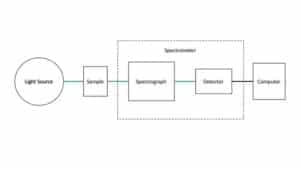The term “spectroscopy” is used to describe experiments that study the interaction of the electromagnetic spectrum (light) and matter. All spectroscopy experiments have the same basic components:

The light source emits electromagnetic radiation. Previously, only visible light was used, but advances in technology have made it possible to emit any part of the electromagnetic spectrum, such as UV or NIR light. The radiation interacts with the sample, the piece of matter that the scientist wants to study. The radiation is then sent to a spectrograph, which separates the radiation by wavelength into a spectrum. The spectrum is recorded by the detector. Most current detectors are digital, so the results are read by a computer. Together, the spectrograph and the detector are referred to as the spectrometer.
(813) 855-8687
ContactUs@StellarNet.us





